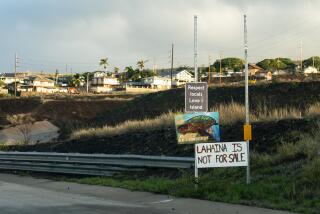Hawaii Lesson: Soaring Values Carry Big Risk
One of the signs that attitudes have changed from the high-inflation days of the 1970s is that real estate is no longer the hot investment it was. Instead of assuming they’ll see a quick profit, investors generally are looking farther ahead, if they’re investing at all.
The change is particularly apparent in Hawaii, where a good many buyers and lenders have learned a hard lesson about downside risk.
Skyrocketing values in the ‘70s, partly a product of the period’s inflation psychology, led to massive overbuilding of condominiums, resort units and other properties in the islands. Developers banked on strong demand from mainlanders attracted by the idea of a dream vacation home that would turn them a nice profit and give them some tax benefits as well.
Painful Ending
Speculative booms almost always have a painful ending. This one was helped along by a dramatic change in economic conditions. Interest rates soared and inflation cooled.
At one condo development on Kauai, the first units, built in the early ‘70s, sold for as little as $50,000. Just before the boom ended in 1979, some of them reached nearly $200,000. Just as in Orange County and other parts of California, demand was so great that new units often were sold by lottery.
Now times have changed. One Californian who bought into the Kauai project at $160,000 now figures he’d be lucky to get $125,000 for his unit. There are others on the market for as low as $90,000. “If we’d known how much building was planned, we might not have bought,” he says. “But times were so good, we didn’t ask that many questions. And even if we had, we might have gone ahead anyway.”
Fortunately for this investor, he wasn’t one of those who bought on a shoestring, expecting to be able to get out quickly as prices rose. He has watched while other owners have lost their units. He considered walking away, but in Hawaii, unlike California, lenders can go after a borrower’s other assets, not just the real estate investment, to satisfy a debt. “That’s something else I wish I’d understood going in,” he says. At present, he plans to hang on for better times.
11% Vacancy Rate
Hawaiian property generally hasn’t fared as badly as his condo. But prices have come down some. One Honolulu business executive figures a condo he purchased for $65,000 in the early ‘70s got as high as $225,000 before dropping back to a current $195,000. There’s still an overhang of some 11,000 condos on the market, a vacancy rate of 11%.
Some units were built as part of resort complexes and are operated like hotel rooms. In these cases, rental income frequently has been disappointing for investors because occupancy rates have been low for much of the last five years.
This year, tourism is up and some resorts are sold out at least for the current peak season. But in some cases, room rates remain depressed by the oversupply of recent years.
While the Hawaiian speculative boom was unusually sharp, it was much like most booms elsewhere. What starts out as a healthy appreciation in values based on real demand turns unhealthy as the speculators join the serious investors in scrambling for property. That certainly happened in parts of California, where builders sold lots by lottery but many of the buyers had only one idea in mind--a quick resale and a quick profit.
In the end, there have to be people who want to occupy all the new units, or the bubble bursts. In many cases there weren’t, and so it did.
Tax policy has played a role in some of this speculation, contributing the benefits of tax write-offs to the lure of exploding land values. Now, the proposed tax simplification plans being considered by Congress and the Administration would put a cap on deductions for interest paid on the mortgage loan for second homes. That has frightened would-be investors and compounded the overbuilding problem.
The lesson of the Hawaiian experience is a simple one. When prices of any investment, real estate included, go sky-high, it’s best to remember how far is down.
More to Read
Inside the business of entertainment
The Wide Shot brings you news, analysis and insights on everything from streaming wars to production — and what it all means for the future.
You may occasionally receive promotional content from the Los Angeles Times.










